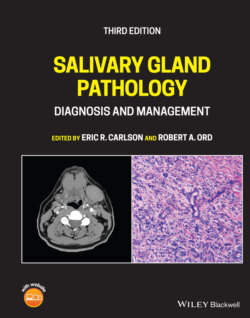Читать книгу Salivary Gland Pathology - Группа авторов - Страница 57
Imaging Modalities COMPUTED TOMOGRAPHY (CT)
ОглавлениеComputed tomography (CT) has become indispensable in the diagnosis, treatment, and follow‐up of diseases of the head and neck. The latest generation of multiple‐row detector CT (MDCT) provides excellent soft‐tissue and osseous delineation. The rapid speed with which images are obtained, along with the high spatial resolution and tissue contrast, makes CT the imaging modality of choice in head and neck imaging. True volumetric data sets obtained from multi‐detector row scanners allow for excellent coronal, sagittal, or oblique reformation of images as well as a variety of 3D renderings. This allows the radiologist and surgeon to characterize a lesion, assess involvement of adjacent structures or local spread from the orthogonal projections or three‐dimensional rendering. The ability to manipulate images is critical when assessing pathology in complex anatomy, such as evaluation of parotid gland masses to determine deep lobe involvement, facial nerve involvement, or extension into the skull base. Images in the coronal plane are important in evaluating the submandibular gland in relation to the floor of mouth. Lymphadenopathy and its relationship to the carotid sheath and its contents and other structures are also well delineated. CT is also superior to MRI in demonstrating bone detail and calcifications. CT is also the fastest method of imaging head and neck anatomy. Other advantages of CT include widespread availability of scanners, high‐resolution images, and speed of image acquisition that reduces motion artifacts. Exposure to ionizing radiation and the administration of IV contrast are the only significant disadvantages to CT scanning.
